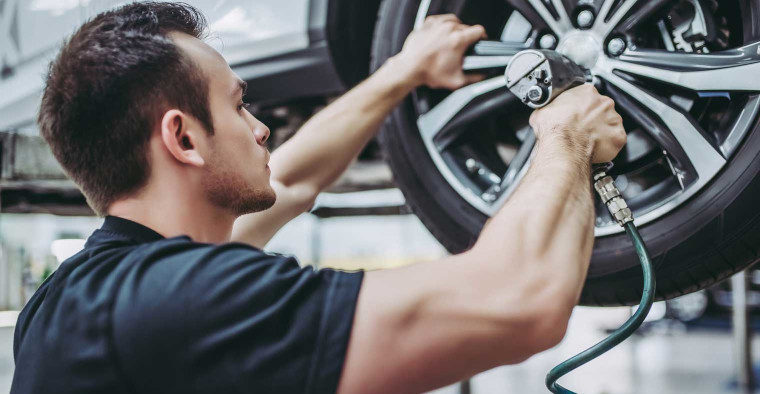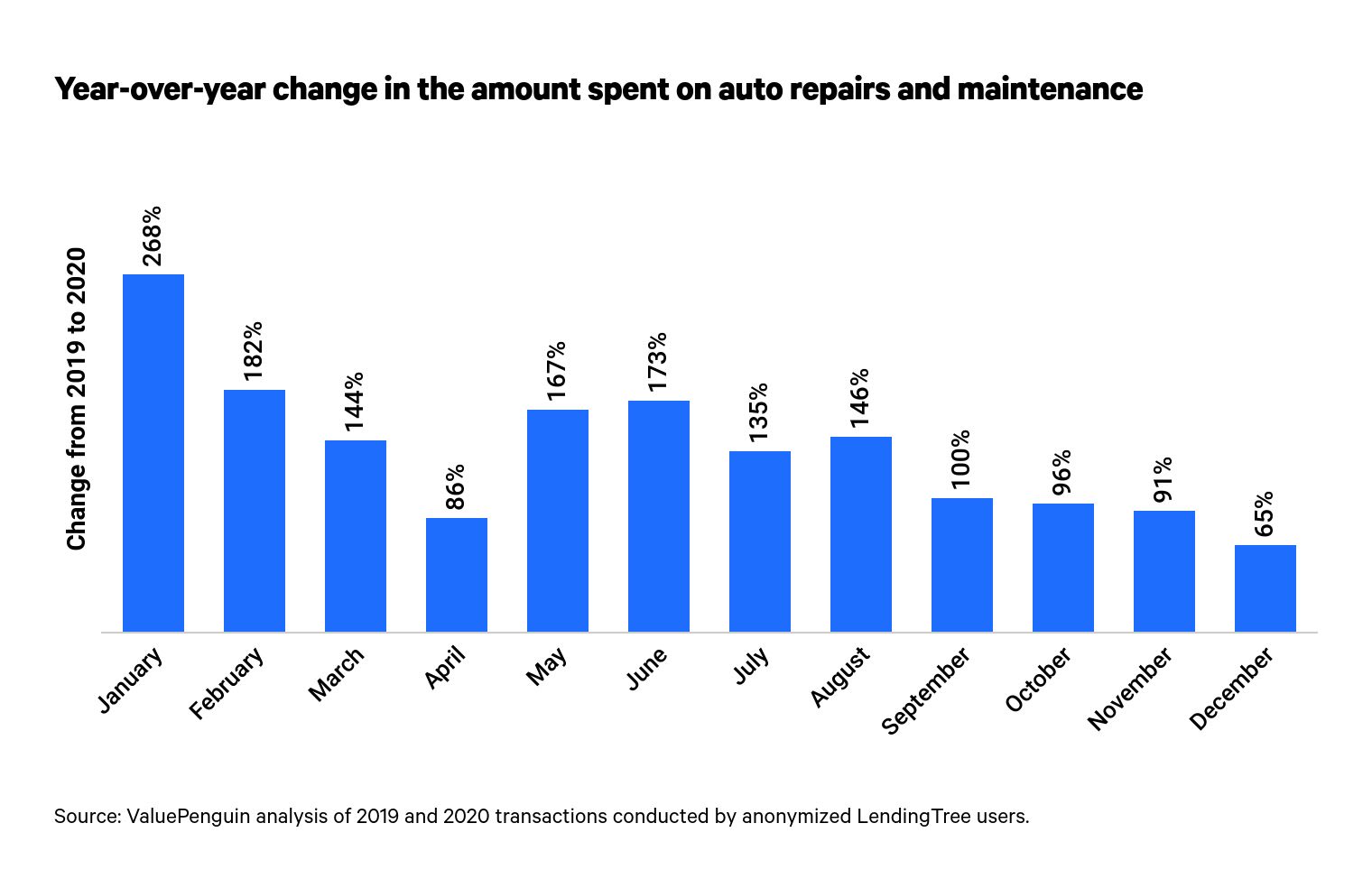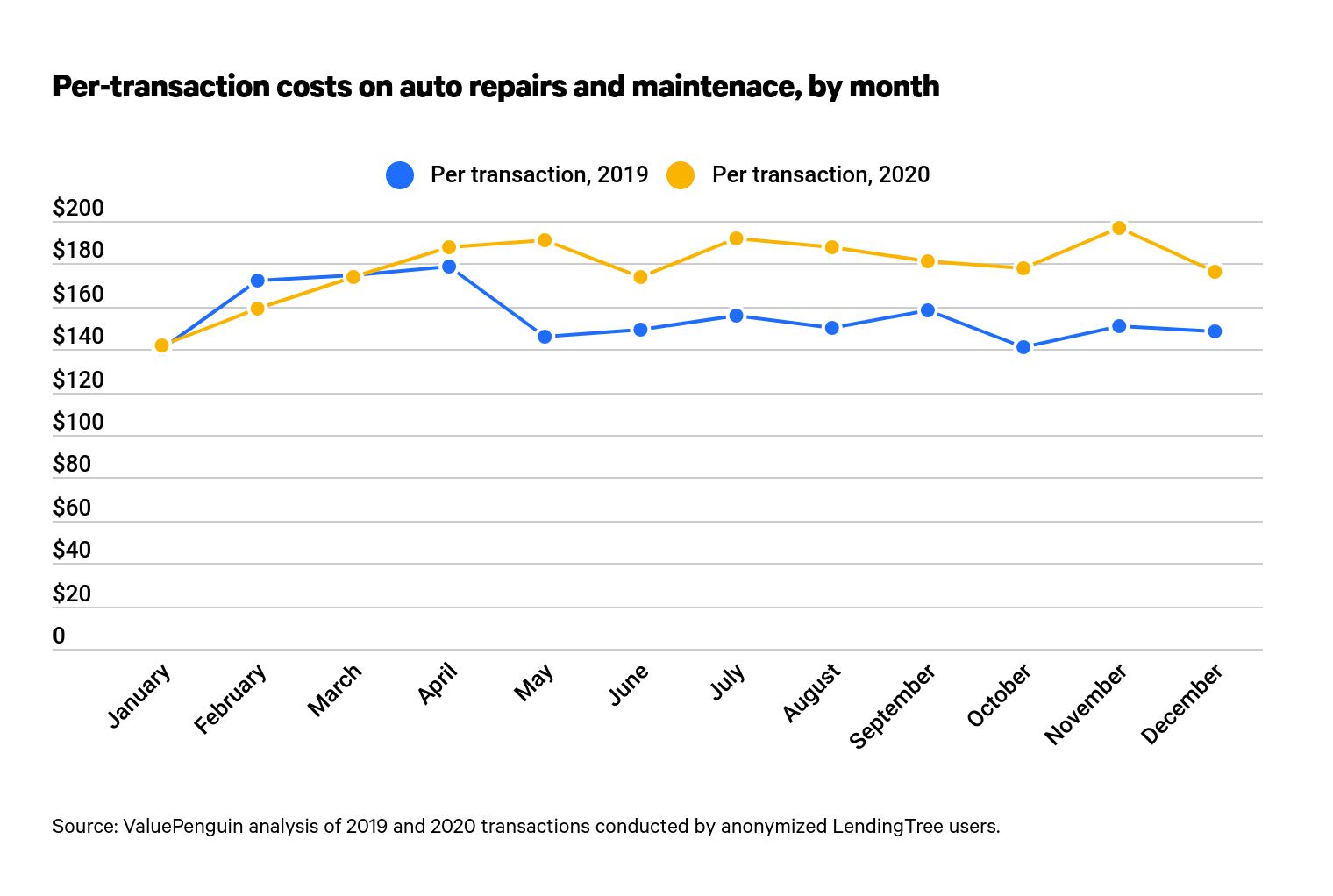Auto Insurance
Despite Traveling Fewer Miles in 2020, Americans Spent 124% More on Car Repairs and Maintenance in 2020 Than the Year Before

While the coronavirus pandemic severely impacted the amount of time Americans spent on the country's roadways, consumers continued to use their money to maintain and care for their cars. While there was a slight drop-off in repair-related expenses at the onset of the pandemic, according to data from LendingTree, our sister site, consumer spending increased throughout the summer and was ultimately 124% greater than it was in 2019.
Consumer spending also rose for repair and maintenance-related incidental expenses, such as car washes and detailing, new tires and towing. ValuePenguin researchers found that the amount of money spent on these services increased by 123% compared to 2019.
The data also revealed the amount Americans spent on repairs and maintenance relative to the distance they traveled. Americans drove a collective 2.8 trillion miles in 2020 — 432.8 billion fewer than the year before. At the same time, consumers spent $4.71 on repairs, maintenance and incidental expenses for every million miles traveled, compared with $1.83 the year before.
Key findings
- Unhampered by the pandemic, consumers spent more money on repairing and maintaining their cars in 2020 than the year before. Expenses for general automotive repairs increased by 124% from the year before.
-
Consumers spent more on automotive upkeep in 2020 than in 2019. Americans spent 162% more on towing, 124% more on new tires and 117% more on car washes and detailing than in the year before.
- The cost of caring for a car rose from 2019 to 2020. Consumer spending for repairs, general maintenance and other incidental expenses went up by 23% in 2020.
- Due to the decrease in miles traveled during the pandemic, the cost of automotive expenses per mile increased steeply in 2020. Drivers across the country combined to spend $4.71 per million miles traveled in 2020, compared to $1.83 in 2019.
Expenses for car repairs and maintenance in 2020 were $352,350 greater per month, on average, than in 2019
The LendingTree consumer spending data examined by ValuePenguin researchers revealed that expenses on automotive maintenance and repairs increased by $4.2 million in 2020 compared to the year before. In 2019, expenses totaled $3.4 million across more than 22,200 transactions and grew to $7.6 million in 2020, though the number of transactions nearly doubled to 42,600.
The coronavirus pandemic contributed to Americans driving 432.8 billion fewer miles in 2020 than in 2019, according to the Federal Highway Administration. Simultaneously, the pandemic created an environment where driving was more attractive than other forms of travel, especially after the initial virus surge in March and April.
According to a previous ValuePenguin analysis, the money spent on car and truck rentals grew by 143% in 2020, with uninterrupted growth from May to September. It's no coincidence that researchers found a similar trend with repair expenses.
The largest year-over-year increase in the amount spent on auto repairs was in January 2020, when consumers spent 268% more than in January 2019.

In each month during 2020, consumers spent more on car maintenance than the year before. Despite this, there was a drop-off in the amount spent on maintenance and repairs at the start of the pandemic. In March 2020, consumers spent 144% more on repairs than in 2019, but that figure dropped to 86% in April. After this point, the amount spent on auto repairs and maintenance compared to the year before increased to at least 100% from May to September before trailing off to 96% in October.
During 2020, consumers among the sample spent an average of $352,350 a month more on maintaining their cars than in 2019. From May to September, when restrictions began to ease, COVID-19 cases began to fall and more people traveled to their summer vacations via cars, per-month expenses grew to $421,515 among the sample. And when the time for summer travel died down after September, consumers spent an average of $316,928 per month from October through December.
In 2020, consumers spent 123% more on incidental costs related to cars than in the year before
As with general maintenance and repair expenses, the amount Americans spent on specific items, including car washes and detailing, new tires and towing, increased compared to 2019. In fact, expenses related to these categories changed similarly on a month-to-month basis as general maintenance did.
Consumers spent a total of $3.1 million more on car washes and detailing, tires and towing across the sample than they did in the previous year.
From March to April, there was a decline in the amount spent compared to 2019 on car washes and detailing, as well as towing. The outlier, in this case, was tires. There was an increase in consumer spending on tires from March to April compared to the year before.
The amount Americans spent on car washes generally followed the same trend as repairs and maintenance. Following a low point in April, the year-over-year change to the amount consumers spent on car washes reached a high point in June before tumbling downward in October. Conversely, expenses toward tires and towing had post-COVID-19 spikes in April and August, respectively.
Americans spent $19 more per transaction on general car repairs and incidental costs in 2020 than in the previous year
While the amount consumers spent on general and specific forms of auto repair and maintenance increased in 2020 compared to 2019, the price per transaction in each sector also grew. Overall, consumer spending per transaction grew by 23% across repair, maintenance and incidental categories.
The largest per-transaction increase of any of these categories was in towing. Americans paid 24% more per instance of towing in 2020 than in the year before. The cost of car washes and detailing services grew by 20% in 2020, while the cost of tires grew by 11%. The cost of general repairs and maintenance grew by 15% per transaction from 2019 levels.

Month | Car wash and detailing | Replacing tires | Towing |
|---|---|---|---|
| Average | $4 | $18 | $30 |
| January | $6 | $12 | $39 |
| February | $3 | $31 | $60 |
| March | $5 | -$13 | $14 |
| April | $4 | $30 | $38 |
| May | $3 | $32 | $23 |
| June | $2 | $4 | $55 |
| July | $4 | $30 | $17 |
| August | $3 | $31 | $19 |
| September | $5 | $22 | $36 |
| October | $4 | $25 | -$27 |
| November | $3 | -$4 | $60 |
Values in the graph have been rounded.
At a broader level, the cost of maintenance per mile traveled increased in 2020. This is the product of higher spending on car maintenance, coupled with the reduction in the distance traveled by drivers during the coronavirus pandemic. In 2019, consumers paid $1.83 per one million miles traveled, but that figure spiked to $4.71 in 2020.
How will car manufacturing and repair expenses change in 2021? Based on data from the first quarter of 2021, the amount spent on automotive repairs is on track to outpace the previous year. Expenses through March 2021 equaled 32% of the previous year's. Spending in 2021 would come to 128% of 2020's if this trend continues.
Does car insurance pay for maintenance and repairs?
Car insurance helps consumers avoid much of the financial costs that follow a crash. A driver's bodily injury and property damage liability coverages pay for damages that a driver causes to another person on the road. Comprehensive and collision coverages, which consumers have to add to a standard policy, pay for damages drivers cause to their own vehicles.
Insurers may also offer additional coverage for custom parts. Similarly, motorcycle insurance providers often offer extra coverage for customized bikes. These forms of auto or motorcycle insurance come with an extra fee on top of the policy's cost, but they may be beneficial depending on the amount of customized features a vehicle has.
Methodology
Using data from 242,095 transactions conducted by anonymized LendingTree users, ValuePenguin calculated the expenses for car repairs and maintenance, car washes and detailing, new tires and towing. We looked at how the money spent on these products changed between 2019 and 2020. We compared it to miles-traveled data published by the Federal Highway Administration.
Readers should note that users of LendingTree tend to skew younger, have lower incomes and have lower credit scores than the national distribution. Both lower incomes and lower credit scores are more common in younger adults.
